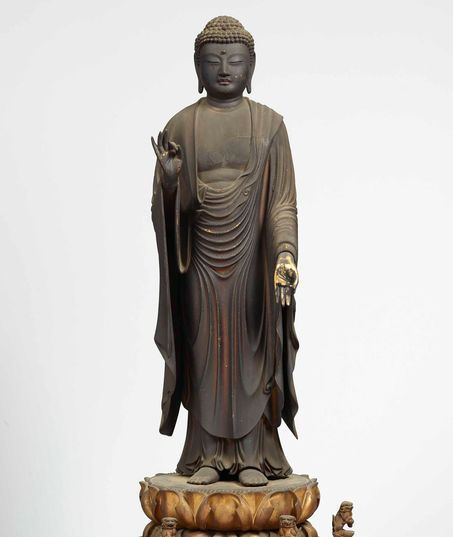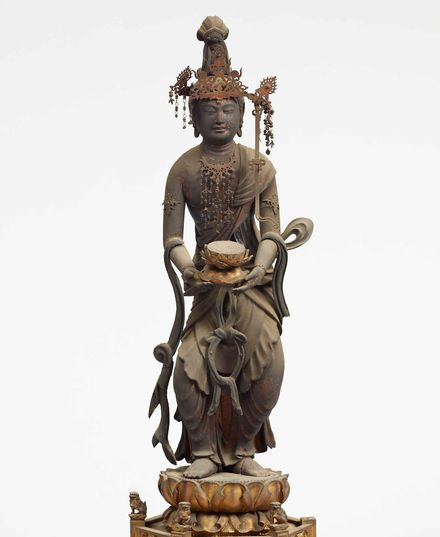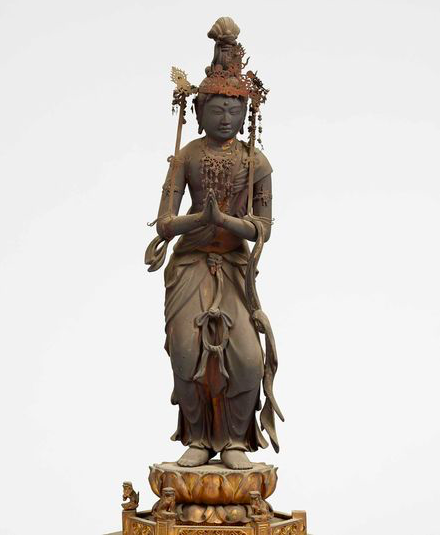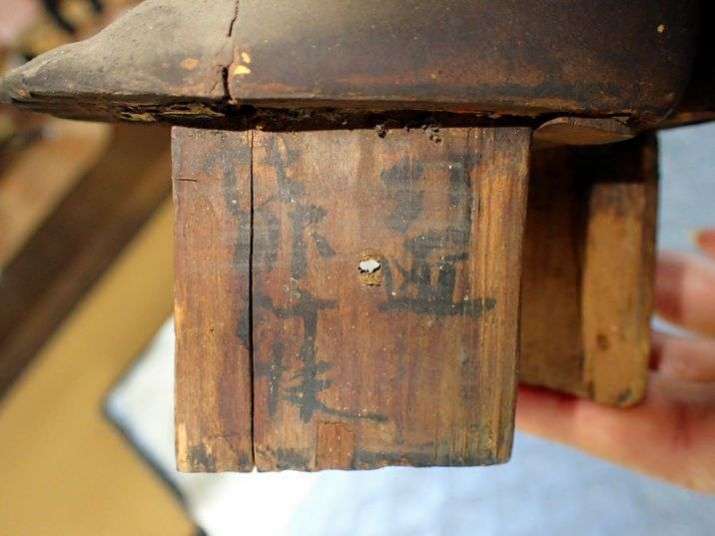
a temple in Kyoto. From asahi.com
During routine preparations for an upcoming special exhibition at Kyoto National Museum in Japan, a staff member made a startling discovery: two of the three statues that will be shown in the exhibition bear the faint inscription of a renowned but obscure sculptor.
Enshrined and venerated for centuries at Monmyo-ji, a temple in Kyoto’s Sakyo Ward, the wooden statues bear the name Gyokai (行快), the senior disciple of the famous Buddhist sculptor Kaikei ( 快慶), also known as Busshi.
The three statues, an 83-centimeter-tall Amida Ryuzo, which is flanked by a 59-centimeter Kannon Bosatsu Ryuzo, and a 58.2-centimeter Seishi Bosatsu Ryuzo, are known together as Amida Sanzonzo.
In preparation for the special exhibition “Art of the Ji Shu,” a staff member of the museum removed the statues from a sacred zushi (altar) cabinet at the temple, which belongs to the Ji Shu (時宗, “Time sect”) branch of Pure Land Buddhism, to be photographed. It was during this process that an ink inscription of the word “Gyokai” was noticed on the bases of two of the statues.

From asahi.com
According to Takeshi Asanuma, head of the Cooperation and Education Department of Kyoto National Museum’s Curatorial Division, who examined the statues and the signatures, they were undoubtedly carved by Gyokai and the signatures match the artist’s handwriting.
Although Gyokai’s signature was not found on the Amida Ryuzo statue, Asanuma said that this statue was probably also carved by Gyokai since it too matches the characteristics associated with the master carver. Asanuma estimates that the Amida Sanzonzo was carved between the late 1230s and 1240s, when Gyokai was head of a sculptor’s studio, describing the statues’ appearance as vigorous and clean-cut.
The discovery is remarkable since little is known about Gyokai and only seven of his works are known to exist. The museum described the discovery as “important for studying Gyokai, a figure shrouded in mystery.” (The Asahi Shimbun)

From asahi.com
Gyokai lived during the first half of the 13th century, during the Kamakura period (鎌倉時代, 1192–1333), when political power in the country shifted from aristocratic rule in the west of Japan (Kyoto, Nara) to the shogunate in Kamakura in the east. The Kamakura period is also notable for the flourishing of Buddhism across the country—in particular Zen Buddhism and the Jōdo-shū branch of Pure Land Buddhism.
This politically and socially turbulent period was also a high point in the history of Japanese sculpture, as artists began incorporating stylistic and technical innovations that resulted in a level of realism not previously seen. Sculptors of the era also began signing their work, enabling the evolution of styles by individuals and workshops to be traced and documented. Sculptors in the 18th century could trace their artistic lineages back to early Kamakura masters.

Gyokai was part of the Kei school, founded Kōkei (the teacher of his own teacher Kaikei), which became the dominant sculptural school until the 14th century. It specialized in sculpting statues of the Buddha and other important Buddhist figures.
Gyokai, in addition, inherited the Annami-yō (安阿弥様) or Annami style, developed by Kaikei, from his teacher. The Annamistyle of sculpting was based in the realism of the Kei school but added a charming delicate grace and dignified beauty. Gyokai eventually obtained the rank of hogen (法眼, lit. eye of the law), the second-highest Buddhist rank awarded to artists in those days.
The Amida Sanzonzo will be displayed at Kyoto National Museum from 13 April–9 June.
See more
Kyoto museum solves mystery of who carved ancient statues (The Asahi Shimbun)
Buddhist Sculptures Identified in Japan (Archeology)
Priest Shinkyō 700th Memorial Special Exhibition: ART OF THE JI SHŪ (Kyoto National Museum)
Kaikei & Kamakura Statuary (Japanese Buddhist Statuary)













